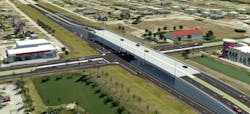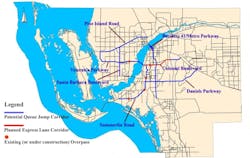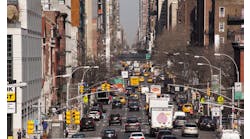By: Robert W. Poole Jr. and Chris R. Swenson, P.E.
Priced “managed lanes” (MLs) are one of the great transportation success stories of the past decade, with such lanes now in operation on expressways in many metro areas and new megaprojects adding such capacity in the Dallas, Fort Worth, Miami and Washington, D.C., areas. Because the ML concept has worked so well on congested expressways, there is growing interest in seeing if the idea can be applied to congested arterials, as well.
Because arterials are not limited-access facilities, the practical difficulties of converting some arterial lanes into priced MLs have thus far appeared overwhelming. By their nature, arterials must provide access to adjacent parcels of land. Thus, any exclusive lane—whether in the center or on the outside—would conflict with such ingress and egress. Arterials intersect with cross streets, generally via signalized intersections. These roads must share the common intersection, and signal green time given to one reduces the capacity of the other and vice versa.
The 2002 Value Priced Queue Jump Study in Lee County, Fla., examined the possibility of using grade-separated overpasses at congested intersections to allow drivers who were willing to pay an electronic toll to bypass the traffic signal and its queue. It found that from an operations standpoint queue jumps are feasible. Focus groups and stated preference surveys found positive response to the concept. Queue jumps were presented as a choice for the driver, with the ability to remain at-grade and traverse the intersection in the usual manner. Suggested tolls were relatively small, ranging between $.10 and $.50 per queue jump.
For managed arterials, grade separations allow drivers to bypass queues at a traffic signal for the movement for which the grade separation was developed.
Jumping the turnstile
Initial projections of revenues and costs indicated that queue jumps were not likely to be financially feasible using traditional toll-revenue bond financing. However, the net present value (NPV) of the revenue stream did exceed the cost of construction even when maintenance was taken into account.
The concept was revived in Lee County as part of a Reason Foundation mobility study. After considering several options, the study team selected the concept of a series of tolled queue jumps as the most viable option for reducing congestion on arterials. Under this concept, selected major arterials would be upgraded with grade separations at major crossing arterials. From this decision, the concept of Managed Arterials (MA) was developed.
In the Reason study, the financial and operational feasibility of Managed Arterials was developed at a sketch level. No major operational stumbling blocks were identified. MAs, like their stand-alone counterpart queue jumps, were found to be financially feasible (NPV of revenues exceeding NPV of costs).
The MA concept recognizes that arterial capacity is defined by intersection capacity. Traffic signals must, by design, reduce the capacity of both roadways by reducing the amount of time each has to allow traffic to flow. “Green time” is the amount of time allotted to a certain movement and is usually expressed as a percentage. For example, if an arterial road has a capacity of 1,800 vehicles per hour per lane if there were no traffic signals, that same arterial would have a capacity of 1,080 vehicles per hour per lane if that movement received green time for only 60% of the hour (.60 × 1,800). Sixty percent is a relatively large amount of green time for any one movement to have. Taking into account the cross-street through movements, protected turning movements and lost time for clearance intervals, the amount of green time even for major movements can easily fall below 50%.
For MAs, grade separations at the intersections allow drivers to bypass queues at a traffic signal for the movement for which the grade separation was developed. This would usually be the through movement on the most heavily traveled of the two intersecting roadways. The movement for which the grade separation was developed can still be made at-grade at the signal. Thus, drivers have a choice: Remain at-grade and proceed through the signalized intersection or use the queue jump to bypass congestion for a toll. If variable tolls are used to manage this capacity, arterial speeds can be maintained, improving operating speeds and, likely, reliability.
Queue jumps can be overpasses or underpasses.
To allow for the grade separation to be fully developed, traffic using it must separate from the general-lane traffic approximately 1⁄4 mile upstream of the intersection. Unless queues at the intersection are longer than 1⁄4 mile, there is no incentive for drivers to “jump in” and “jump out” of the lanes that will be using the grade separation. In this case, it is unlikely that an exclusive lane between the queue jumps would be needed.
Premium for a toll
All vehicles using the queue jump receive the benefit of intersection avoidance. All grade-separated lanes are therefore premium lanes, and tolls are collected from all vehicles using the grade separation.
To allow for the grade separation to be fully developed, traffic using it must separate from the general-lane traffic approximately 1⁄4 mile upstream of the intersection. Unless queues at the intersection are longer than 1⁄4 mile, there is no incentive for drivers to “jump in” and “jump out” of the lanes that will be using the grade separation.
Traffic in the outer lane of the arterial would continue at-grade to the intersection and pay no toll. Vehicles wishing to use the queue jumps would continue in or merge into the lanes accessing the queue jump.
Tolls are charged only on the new capacity (the grade separations). Since the grade separation itself naturally separates tolled from untolled traffic, it is the appropriate location for toll collection and enforcement to occur. Electronic toll collection (ETC) has become a mature technology, and is well understood.
Tip of the cap.
A major benefit of the grade-separated approach is its ability to add significant capacity compared with adding a new lane along the entire corridor. Using generalized capacity tables from the Florida Department of Transportation (FDOT), a six-lane arterial with less than two signalized intersections per mile with right turn lanes has a daily capacity of 58,065. Adding two lanes to make an eight-lane arterial would result in a capacity of 77,490 vehicles per day (VPD), a 33% increase in capacity.
For the MA alternative, again with a base case of a six-lane roadway, the roadway would connect to a four-lane (two lanes in each direction) grade separation with one through lane proceeding at-grade to the intersection each way. The grade separation has a daily capacity of 72,800 VPD based on the capacity of a four-lane, uninterrupted-flow highway. The at-grade lanes act conservatively as a two-lane divided arterial, with a daily capacity of 18,150 VPD. The total capacity of the cross section is then 90,950 (72,800 + 18,150) VPD, 17.4% greater than the eight-lane arterial. If the single lane proceeding to the at-grade intersection is expanded to two through lanes at the intersection, the at-grade capacity more closely resembles a four-lane arterial resulting in a total capacity of 109,500 VPD. This capacity is more than 40% greater than an eight-lane arterial.
While corridor capacity is much improved if a series of queue jumps is implemented, there can be significant improvement with the implementation of individual queue jumps. It is reasonable to construct queue jumps at those locations that are imposing the greatest corridor delay. Modeling performed for the 2002 Lee County study indicated that the time advantage received from an individual queue jump is maintained by the vehicle through the corridor. This is due to the fact that vehicles using an isolated queue jump can advance from one platoon of vehicles to the next.
Reasonable sketch
In a forthcoming Reason Foundation policy paper, authors Swenson and Poole propose a number of MA corridors for southeast Florida. For a generic underpass cost, we began with the recently built underpass in Miami-Dade County on U.S. 27, completed in 2006 at $35 million. We inflated its cost to $38 million in 2010 dollars and added a 10% contingency for underground utility relocation for a total cost of $41.8 million per underpass with a total cost for 14 corridors of $3.74 billion.
Revenue is based on a price schedule of $.35 per underpass traversed during peak periods, $.15 per underpass during off-peaks and $.20 per underpass during weekends and holidays. Based on traffic estimates from the Florida DOT, total annual revenue of $283 million is estimated for the complete set of 14 corridors. Using a toll-bond-revenue rule of thumb that a post-ramp-up toll-revenue stream can finance capital costs equal to approximately 10 times the annual revenue, that revenue stream might support $2.8 billion in capital costs. That is about 75% of the $3.74 billion estimated cost. It should be emphasized that this is a sketch-level analysis only.
Cross-street pollination
All drivers benefit, regardless of whether they use the queue jump itself. MAs as well as isolated tolled grade separations can reduce congestion on all approaches to the intersection. While the benefits to the approach served by the queue jump are obvious, the green time that would have been required for vehicles that now use the MA grade separations can be distributed to other approaches, either the cross streets or the turning movements, to reduce congestion problems on those approaches as well.
Bus rapid transit (BRT) is increasing in popularity in the U.S. Besides being considerably less costly than rail transit, BRT buses can utilize ordinary streets in addition to a guide way, thereby offering greater flexibility and more potential one-seat rides.
Transportation planners in southeast Florida have developed plans for bus-only lanes for BRT service on some of that region’s most congested six-lane arterials. However, demand for BRT service seldom requires more than 28 buses per hour during peak periods. That uses only a very small fraction of a major arterial lane’s capacity.
Modeling performed for the 2002 Lee County study indicated that the time advantage received from an individual queue jump is maintained by the vehicle through the corridor. This is due to the fact that vehicles using an isolated queue jump can advance from one platoon of vehicles to the next.
By contrast, the MA concept increases the throughput of the existing arterial. Premium BRT service (which would operate primarily from suburban park-and-ride lots to major activity centers, with few or no intermediate stops) could make use of the grade separations to offer faster speeds than available on any of the currently operational bus-only lanes. Not all BRT service using the MAs would offer this kind of super-express service. Some might make several intermediate stops at major intersecting arterials. Such stops would enable transfers between bus routes operating on the intersecting arterial and the BRT services operating on the MA. The lowest-cost way to offer this would be for the premium BRT bus to leave the central lanes and traverse the signalized intersection to a conventional bus stop (on either the near side or the far side of the intersection). More desirable from a time-saving perspective would be to integrate a transfer station into the grade separation.
This MA concept replicates several factors that have made priced managed lanes successful. First, using them is optional. Drivers have a choice between existing, congested service at no charge and faster, more-reliable service in exchange for a congestion toll. Second, as with most managed-lanes projects, MAs would not charge people for using pavement they already use without charge. Tolls would be paid only by those choosing to use the new capacity—the grade separation.
What fraction of commuters would opt to use the grade separations, and what price they would pay, are still open questions. The estimates in this paper are based only on early focus-group and stated-preference survey results from the 2003 queue-jump study in Lee County, Fla. If those estimates are in the right ballpark, it is possible that some MAs would produce an NPV of revenue in an amount comparable to the cost of adding the grade separations. An initial tolled queue jump project would produce useful data on the demand for such facilities and hence on the financial feasibility of MAs. TM&E
About The Author: Poole is director of transportation policy at the Reason Foundation, Los Angeles. Swenson is senior supervising engineer with Parsons Brinckerhoff.





